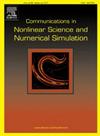Stability and bifurcation analysis of a Holling–Tanner model with discontinuous harvesting action
IF 3.4
2区 数学
Q1 MATHEMATICS, APPLIED
Communications in Nonlinear Science and Numerical Simulation
Pub Date : 2025-02-24
DOI:10.1016/j.cnsns.2025.108720
引用次数: 0
Abstract
This work addresses the study of dynamics and bifurcations in a prey–predator model, known in the literature as the Holling–Tanner model, subject to a harvesting action of predators that is activated when the prey population is less than a certain threshold, and stopped otherwise. Such a model is represented by a piecewise smooth system with a switching boundary given by a straight line that is defined by the threshold established for the prey population. Under certain conditions on the system parameters, a pseudo-focus point appears at the switching boundary. Based on the Poincaré map defined in a neighborhood of the pseudo-focus, explicit conditions are given on the system parameters that determine its local stability, the occurrence of Hopf-like bifurcations and the emergence of crossing limit cycles. In addition to Hopf-like bifurcations, other local and global bifurcations such as the classical Hopf bifurcation, the Boundary Equilibrium bifurcations, the Saddle–Node bifurcation of periodic orbits and the Grazing bifurcation are also identified. A complete description of the existence and stability of equilibria and periodic orbits is provided based on the obtained two-parameter bifurcation set, from which the coexistence of four periodic orbits in the phase portrait of the system under study is proved.
求助全文
约1分钟内获得全文
求助全文
来源期刊

Communications in Nonlinear Science and Numerical Simulation
MATHEMATICS, APPLIED-MATHEMATICS, INTERDISCIPLINARY APPLICATIONS
CiteScore
6.80
自引率
7.70%
发文量
378
审稿时长
78 days
期刊介绍:
The journal publishes original research findings on experimental observation, mathematical modeling, theoretical analysis and numerical simulation, for more accurate description, better prediction or novel application, of nonlinear phenomena in science and engineering. It offers a venue for researchers to make rapid exchange of ideas and techniques in nonlinear science and complexity.
The submission of manuscripts with cross-disciplinary approaches in nonlinear science and complexity is particularly encouraged.
Topics of interest:
Nonlinear differential or delay equations, Lie group analysis and asymptotic methods, Discontinuous systems, Fractals, Fractional calculus and dynamics, Nonlinear effects in quantum mechanics, Nonlinear stochastic processes, Experimental nonlinear science, Time-series and signal analysis, Computational methods and simulations in nonlinear science and engineering, Control of dynamical systems, Synchronization, Lyapunov analysis, High-dimensional chaos and turbulence, Chaos in Hamiltonian systems, Integrable systems and solitons, Collective behavior in many-body systems, Biological physics and networks, Nonlinear mechanical systems, Complex systems and complexity.
No length limitation for contributions is set, but only concisely written manuscripts are published. Brief papers are published on the basis of Rapid Communications. Discussions of previously published papers are welcome.
 求助内容:
求助内容: 应助结果提醒方式:
应助结果提醒方式:


